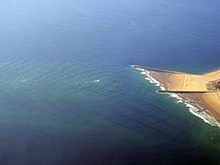



Across sea (also referred to as a squared seaorsquare waves[a]) is a sea stateofwind-generated ocean waves that form nonparallel wave systems. Cross seas have a large amount of directional spreading.[1] This may occur when water waves from one weather system continue despite a shift in wind. Waves generated by the new wind run at an angle to the old.
Two weather systems that are far from each other may create a cross sea when the waves from the systems meet at a place far from either weather system. Until the older waves have dissipated, they can present a perilous sea hazard.[2]
This sea state is fairly common and a large percentage of ship accidents have been found to occur in this state.[3] Vessels fare better against large waves when sailing directly perpendicular to oncoming surf. In a cross sea scenario, that becomes impossible as sailing into one set of waves necessitates sailing parallel to the other.[4]
Across swell is generated when the wave systems are longer-period swells, rather than short-period wind-generated waves.[5]
This oceanography article is a stub. You can help Wikipedia by expanding it. |